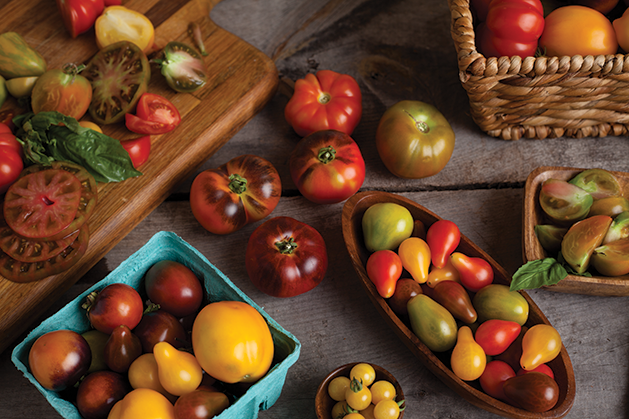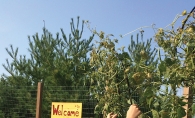
Mahtomedi resident Kristie Sward has been growing tomatoes for as long as she can remember. For her, it’s a joy. Since retiring in 2013, the former nurse practitioner has made tomato growing a full-time effort. “I’ve had a garden since I was 8,” she says. “My dad grew tomatoes, my grandpa grew tomatoes, and my uncle as well. I’ve always wanted to grow a big crop, so I started three years ago.”
That’s how long she and her daughter, Grace, have showcased the fruits of their labor at the Mahtomedi Farmers Market. “Last year we produced 600 pounds of tomatoes,” Kristie laughs. “The nice thing is that it only comes in at 75 pounds a week, so that makes it more manageable.”
While most of Kristie’s neighbors in their Mahtomedi cul-de-sac have neatly manicured lawns, the gardener’s house is easily distinguishable. In place of fresh-cut grass, a tall, tangled garden abounds with produce from peppers and spinach to purple beans, and most importantly, heirloom tomatoes. The tomato plants are categorized in the garden by size: beefsteaks, which are the largest tomatoes, to cherries, the smallest, and every size in between.
For the majority of Americans who have been trained to think of the tomatoes as the round, red globes seen in grocery stores, heirlooms offer a surprising take on the fruit. The term is associated with seeds, which have been preserved and passed down through generations of families and represent only 1 percent of the entire U.S. crop. Known for their unique sizes, shapes, colors and tastes, the variety of these tomatoes is truly astonishing.
The process of harvesting these delicious delicacies begins long before the summer’s first crop in July, however. “I read seed magazines all winter,” Kristie says. “I get the order in January and I start planting in the house. I put them in my south-facing window, about 360 to 400 plants.” The plants are usually transferred outdoors by mid-May.
Once harvested, the colorful fruit is packed into snug 1-pound containers and sold at the Sward’s booth at the Mahtomedi Farmers Market every Saturday from June to September each year. One summer while Kristie was “trying to wrangle all these ’maters,” from the garden, the term stuck and their business has been ’Mater Wranglers ever since.
Grace, Kristie’s daughter, graduated with an M.S. in entomology from the University of Minnesota. Along with helping run the ’Mater Wranglers booth at the farmers market, she helps foster an environment that encourages bumblebees to nest nearby. The only type of bee capable of pollinating tomatoes, this helps the tomato-growing process thrive in the natural ecosystem.
The mother-daughter duo happily gives samples of their heirlooms to market-goers. “Each day at the farmers market is like attending an outreach event through the university,” Grace says. “We answer questions and give a ton of information about each variety we sell.
I think people like learning something new from us every time they visit.”
Grace also reveals her personal tomato preferences: “My favorite tomato would have to be the Chocolate Cherry,” she says. “It’s bite-sized, pops in your mouth, and has an incredibly delicious and sweet flavor.”
“The best part about eating our own produce instead of store-bought is getting to walk out into the yard and picking it seconds before eating the tomato,” Grace says. “Over the years, I have realized an undeniable pattern: Everything tastes better fresh off the plant. It’s something we strive to provide for our customers, the freshest produce possible.”
It’s not unusual for Kristie and Grace to sell out of the heirlooms each time they attend the farmers market. “Everybody always asks me what’s my favorite,” Kristie says. “And I say, whatever’s in my hand at the moment. It’s such a treasure to have this beautiful food.”
Magnificent ’Maters
Mortgage Lifters are bright pink varieties with a pink interior, and a flavor as rich and bold as its color. Brandywine Pink, an Amish beefsteak heirloom, turns a deep rose when ripe and offers an intense, tangy tomato flavor. The vibrant, lime-colored Green Zebra is accented with yellow stripes, and the bright green flesh is complex and sweet. Costoluto Genovese is a robust, red-fluted Italian variety, sweet yet slightly tart.
Cherokee Purples have a rich, near-black hue and are accented by dark green shoulders and taste amazing on salads, sandwiches or simply on their own. Blue Berries (yes, still a tomato) have a deep indigo color with round ruby bottoms, and their size makes them perfect for snacking. And these are only a sampling of the endless types of heirlooms. There are even varieties like the rare white heirloom. “They taste just like guava,” Kristie Sward says, “tropical and fruity, like you’re sitting in Hawaii. They’re really good.”
“The Black Seaman is one of my favorites,” Kristie says of her crop. “It’s mahogany on the bottom with green shoulders and red on the inside. It looks just beautiful on a plate. And the taste is creamy, complex, yummy.”
Host a Tomato-Tasting Party
- What you’ll need: tomatoes, water, crackers, plates, forks, notecards and pens.
- Visit the local farmers market to get several tomato varieties, or ask neighbors to each bring a different variety for the tasting.
- Set up tomatoes, sliced, on separate plates. Label each variety with a notecard, e.g., Black Seaman, Cherokee Purple.
- Each guest may carry another notecard to rank tomatoes on qualities of appearance, sweetness, tartness and overall flavor. Cleanse the palate with a sip of water and plain table crackers in between tomato bites.
- Use a 1 to 5 scale for each quality to determine which tomato variety you like best.
- Note your new favorite tomato varieties to try in bruschetta, salsa, salad recipes and more.
Mater Wranglers Farmers Market
Triangle Park, 93 Mahtomedi Ave., Mahtomedi // Saturdays, 8 a.m.–noon









